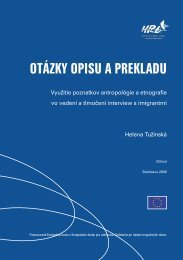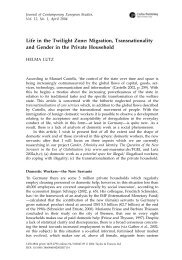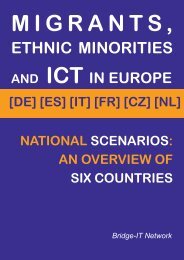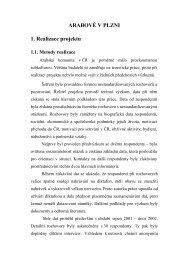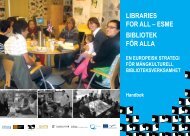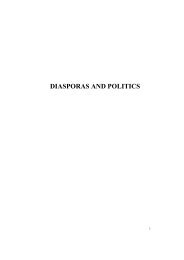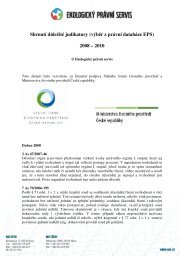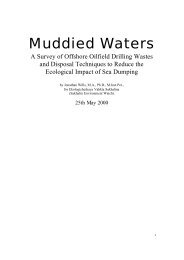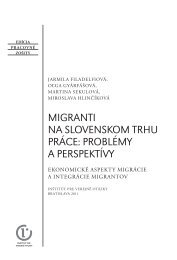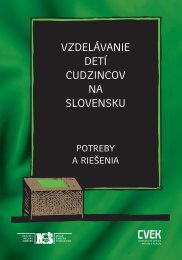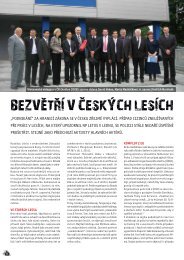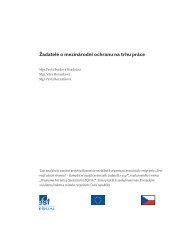Migration Processes in Central and Eastern Europe - Multiple Choices
Migration Processes in Central and Eastern Europe - Multiple Choices
Migration Processes in Central and Eastern Europe - Multiple Choices
You also want an ePaper? Increase the reach of your titles
YUMPU automatically turns print PDFs into web optimized ePapers that Google loves.
———————————————————————————————————————————————————————————————<br />
Refugees <strong>in</strong> <strong>Central</strong> <strong>and</strong> <strong>Eastern</strong> <strong>Europe</strong><br />
———————————————————————————————————————————————————————————————<br />
60<br />
quently they hide away from members of the problematic<br />
groups with whom they have become <strong>in</strong>volved, or they just<br />
disappear. A weakened family looses its source of livelihood<br />
<strong>and</strong> becomes an easy target for those elements <strong>in</strong> society<br />
who take advantage of other’s misfortune. This can lead to<br />
threats, <strong>in</strong>timidation, forced labour <strong>in</strong> order to pay outst<strong>and</strong><strong>in</strong>g<br />
debts or sexual violence. It is no wonder women are<br />
usually the <strong>in</strong>itiators of migration; a family <strong>in</strong>curs a debt,<br />
a customary law is breached (e.g. marriage with a foreigner),<br />
or people with different sexual orientation are stigmatised.<br />
It is important to take <strong>in</strong>to consideration the circumstances<br />
under which immigrants left their homes. Dis<strong>in</strong>tegration of<br />
social structures effects families <strong>and</strong> forces their members,<br />
who might become a target of dangerous activities, to<br />
leave. They consider their departure as def<strong>in</strong>itive because<br />
their return would have fatal consequences. The door is<br />
def<strong>in</strong>itely closed <strong>and</strong> the hope that the situation would<br />
improve is negligible.<br />
Unsupported immigrants do not perceive their<br />
strategy of settlement as a f<strong>in</strong>al anchorage; they know that<br />
their idea of permanent haven is false, <strong>and</strong> might change<br />
quickly. Whether they flee <strong>in</strong>dividually or disperse, they are<br />
exposed to that permanent risk. They labour hard to avoid<br />
such a risk. They have been thrown <strong>in</strong>to the wider world<br />
<strong>and</strong> so they temporarily use the asylum welfare network to<br />
deal with the massive upheaval <strong>in</strong> their lives. This network<br />
does not provide any solutions for them, because often the<br />
life stories of the asylum seekers are so similar, consequently<br />
it is difficult to prove the validity of their stories. The network<br />
also fails to support those whose reasons to flee their<br />
homel<strong>and</strong> do not fall under any article of the Geneva<br />
Convention. The immigrants' strategies are escapist; each<br />
settlement is considered as temporary. In addition, they<br />
do not have relatives or friends <strong>in</strong> the country to help them.<br />
A bad experience with the crim<strong>in</strong>al world would force them<br />
to avoid any more contact with this world, which appears<br />
as treacherous <strong>and</strong> destructive. That is why they accept<br />
temporary solutions <strong>and</strong> so <strong>in</strong>itiate the asylum process.<br />
When an entire family departs, it shr<strong>in</strong>ks<br />
traditional relationships <strong>in</strong>to a nuclear space. Family<br />
members choose one out of two strategies: either they<br />
dissipate to various countries <strong>and</strong> ma<strong>in</strong>ta<strong>in</strong> the prospect<br />
of reunification while <strong>in</strong>quir<strong>in</strong>g <strong>in</strong>to <strong>and</strong> evaluat<strong>in</strong>g possibilities<br />
of reunification; or they settle with<strong>in</strong> one country <strong>and</strong><br />
come together through the asylum procedure either at the<br />
same time or one-by-one. The choice of strategy is often<br />
related to various circumstances. For <strong>in</strong>stance a pregnant<br />
daughter enters first, the mother follows <strong>and</strong> the son enters<br />
last because he has been tak<strong>in</strong>g care of hous<strong>in</strong>g outside<br />
the asylum centre. In do<strong>in</strong>g so, the asylum claim can have<br />
a different significance for each of them – health protection<br />
for the daughter <strong>and</strong> her <strong>in</strong>fant, safety for the mother <strong>and</strong><br />
legalisation of the stay <strong>and</strong> ga<strong>in</strong><strong>in</strong>g of social contacts for<br />
the son.<br />
Asylum proceed<strong>in</strong>gs also provide an escape for<br />
people with alternative sexual orientations if they are<br />
experienc<strong>in</strong>g negative consequences as a result of reveal<strong>in</strong>g<br />
their sexuality. The great strategies are escapist, whilst the<br />
small strategies reflect day-to-day life. With regards to<br />
people with different sexual orientations, an asylum facility<br />
either provides them with a hideaway from stigmatisation<br />
or with the first opportunity to “come-out” freely. It is no<br />
wonder that camouflage practices are notable parts of<br />
escapist strategies. Their goals are to ga<strong>in</strong> the protection<br />
provided by the asylum facility's employees; by dim<strong>in</strong>ish<strong>in</strong>g<br />
contacts with other room-mates, conceal<strong>in</strong>g their stories<br />
<strong>and</strong>, if necessary because of health reasons, avoid<strong>in</strong>g new<br />
sexual contacts. Tolerance <strong>and</strong> sympathy are expected<br />
only outside the space where potentially endanger<strong>in</strong>g<br />
countrymen are still to be found.<br />
Asylum seekers devote their time of stay <strong>in</strong><br />
facilities to <strong>in</strong>quire about the possibilities the Czech Republic<br />
has to offer. Costs <strong>and</strong> energy needed for domestication are<br />
also estimated. The behaviour of asylum officials, shop<br />
assistants or children go<strong>in</strong>g to school are generalised <strong>and</strong><br />
taken as a pattern of the whole society. Asylum seekers<br />
consider what they can expect from society <strong>and</strong> to what<br />
degree the majority's behavioural traits will impact upon<br />
them. When tak<strong>in</strong>g <strong>in</strong>to account their past experiences,<br />
it is unsurpris<strong>in</strong>g that asylum seekers undertake these<br />
evaluations.<br />
CONCLUSION<br />
It is obvious from the mentioned strategies that<br />
the image of a passive refugee is not <strong>in</strong> accordance with<br />
the complex reality. The strategies refer to a number of<br />
experiences <strong>and</strong> desires which are typical for many asylum<br />
seekers. Life goals are mostly situated outside asylum<br />
facilities, nevertheless, they <strong>in</strong>fluence prospectors' actions<br />
on the <strong>in</strong>side, suggest<strong>in</strong>g that life goals may be of more<br />
significance than the daily reality of survival. Prospectors<br />
will undoubtedly rema<strong>in</strong> set <strong>in</strong> their ways. This paper is<br />
unlikely to change the procedures prospectors carry out<br />
<strong>in</strong> order to select, explore or develop preferences. The vast<br />
<strong>and</strong> complex processes <strong>in</strong>volved <strong>in</strong> claim<strong>in</strong>g asylum, such<br />
as co-operation of various social partners, political <strong>in</strong>fluences,<br />
the m<strong>in</strong>imum st<strong>and</strong>ards of service provided, flexibility, the<br />
extent of <strong>in</strong>tegration <strong>and</strong> the implementation of the Geneva<br />
Convention all underst<strong>and</strong>ably lead to many dilemmas with<br />
which the prospectors, as active participants <strong>in</strong> the asylum<br />
procedures, have to cope.<br />
<strong>Migration</strong> <strong>Processes</strong> <strong>in</strong> <strong>Central</strong> <strong>and</strong> <strong>Eastern</strong> <strong>Europe</strong>: Unpack<strong>in</strong>g the Diversity



